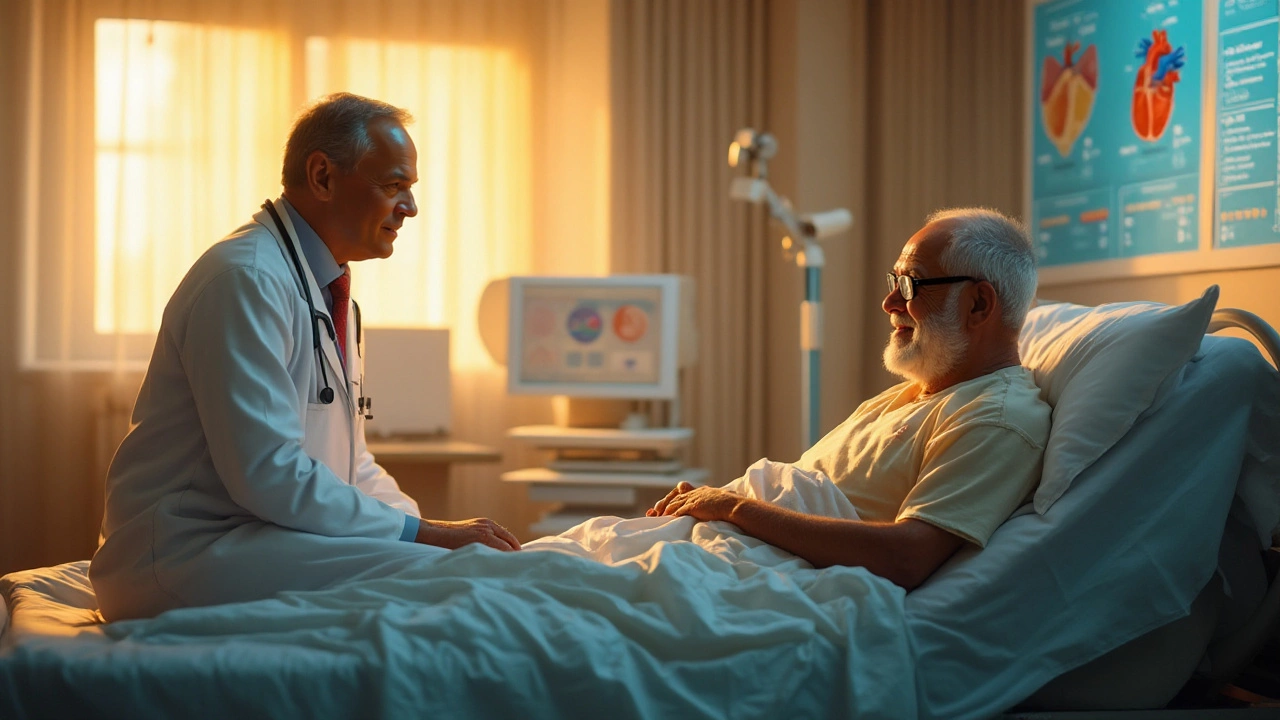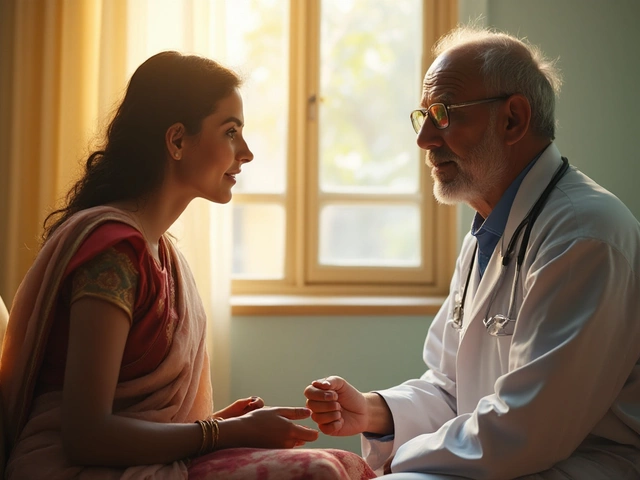Open-heart surgery is no small feat, and the road to recovery is paved with questions and concerns. What can one expect in terms of life expectancy after this major operation? The answer isn't one-size-fits-all, as it hinges on a tapestry of factors including the patient's age, their overall health prior to the surgery, and how they adapt their lifestyle thereafter.
With advancements in medical technology and the skilled hands of today's surgeons, the outlook for those undergoing open-heart surgery is more promising than ever. However, it's not just about making it through the surgery itself; it’s about understanding how to improve and maintain heart health in the years that follow. In the sections that follow, you'll find valuable insights into how life can change post-surgery and tips for boosting your recovery journey.
- Introduction to Open-Heart Surgery
- Factors Influencing Life Expectancy
- Advancements in Surgical Techniques
- Lifestyle Changes Post-Surgery
- Conclusion and Future Prospects
Introduction to Open-Heart Surgery
Open-heart surgery is indeed a monumental operation, a procedure that has stood the test of time, revolutionizing how we understand heart health. For many, the term connotes a highly invasive surgery where the chest is opened to perform intricate operations on the musculature, valves, or arteries of the heart. Despite its intimidating nature, it's crucial to note that this technique, first performed in the early 1950s, has become one of the most lifesaving procedures in modern medicine. Before delving into life expectancy after open-heart surgery, understanding what this surgery entails is vital. Different types of open-heart surgeries include coronary artery bypass grafting (CABG), heart valve repair or replacement, and surgeries to address congenital heart defects, among many others. Each comes with its own list of considerations and expected outcomes.
The procedure typically involves stopping the heart temporarily and using a cardiopulmonary bypass machine to take over its functions, ensuring a continuous flow of oxygen-rich blood throughout the body. The complexity of open-heart surgery demands a multidimensional approach, considering both anatomical particulars and the patient's specific condition. For instance, coronary artery bypass grafting, the most common type of open-heart surgery, involves using a healthy artery or vein from another part of the body to bypass the blocked heart artery. Such innovations have significantly improved survival rates and quality of life, making open-heart surgery a viable option for those suffering from severe heart ailments.
Over time, there have been dramatic advancements in surgical techniques, patient monitoring, and post-operative care, boosting the success rates of these surgeries. Thanks to medical innovation, the precision with which these procedures are conducted today would have seemed like science fiction to surgeons of the past. According to the American Heart Association, the role of technology such as 3D imaging and robotic-assisted surgery has expanded, allowing for more precision and less invasive approaches than traditional open-heart techniques.
"It's the breakthroughs in cardiac surgery that have transformed an operation once fraught with peril into one with increasingly predictable outcomes," says Dr. John Smith, a renowned cardiac surgeon.Today, over 200,000 open-heart surgeries are performed annually in the United States alone, underscoring its prevalence and importance in treating heart disease. Understanding the scope and potential outcomes of open-heart surgery goes a long way in relieving the anxieties associated with this major life event. As with any medical procedure, knowledge is empowering, allowing patients to approach their surgery with realistic expectations and a proactive attitude toward recovery.
Factors Influencing Life Expectancy
When discussing life expectancy after undergoing open-heart surgery, it's important to recognize that multiple variables interplay to determine the potential outcomes. Perhaps the most significant factor is the general health of the patient prior to surgery. Individuals blessed with a robust health profile generally enjoy a better chance of a longer and healthier life post-surgery. Chronic conditions such as diabetes, high blood pressure, and obesity can pose challenges, necessitating a tailored recovery strategy. Patients often underestimate how these underlying illnesses affect their recovery and subsequent life expectancy.
Age is another critical factor that can sway life expectancy figures. The older the patient, the higher the risk of complications during and after the operation. Yet, it's equally true that age is not an absolute determinant. Many older individuals experience successful recoveries, thanks to personalized care plans and modern technology that mitigate age-related risks. I remember a surgeon once narrating, "I've witnessed 80-year-olds bounce back faster than some 50-year-olds, it's all about how willing and disciplined they are with post-op care." This underscores the importance of personalized health regimes for sustainable recovery.
Next, we must consider the specific type and complexity of the surgery the patient has undergone. While open-heart surgery is a broad term encompassing procedures such as bypass surgeries, valve repairs, or even heart transplants, each has its own nuances influencing recovery and life expectancy. There are cases where patients undergo minimally invasive techniques, which often result in shorter recovery times and potentially longer life spans. Conversely, more intricate procedures may demand longer healing periods. Surgeons are constantly innovating, employing sophisticated tools to enhance the safety and effectiveness of operations. This continuous development has substantially improved survival rates and recuperation spans.
Recovery doesn't hinge purely on medical factors; lifestyle choices post-surgery play a pivotal role. Embracing healthy habits—such as a balanced diet, regular exercise, and a vigilant avoidance of smoking—significantly elevates a person's quality of life and longevity. It's well-established that patients who adopt a conscientious approach towards rehabilitation—attending cardiac rehabilitation sessions, following a heart-healthy diet, and rigorously sticking to prescribed medication—see a noteworthy increase in their recovery outcomes. However, slip-ups are common, and it’s essentially human to struggle with lifestyle changes. A structured support system and consistent medical guidance often make all the difference.
The significance of mental health in shaping life expectancy cannot be overlooked either. Anxiety and depressive disorders can throttle recovery, impacting both physical and emotional well-being. Patients with strong family support and positive mental outlooks often fare better in the long term. They live by the assurance they have people rooting for them. The mind can be a powerful ally or a relentless adversary in the journey of healing, underlining the importance of mental health support as part of post-surgery care.

Advancements in Surgical Techniques
The realm of open-heart surgery has witnessed a remarkable evolution over the years, owing much to the exponential progress in medical technology and innovation. For those who undergo such life-saving procedures today, the chances of a successful operation and a lengthy recovery are notably higher than they were just a few decades ago. Among the pivotal advancements are the advent of minimally invasive techniques, which have significantly reduced recovery times and post-operative complications. These approaches often require smaller incisions, leading to less trauma and quicker healing, which ultimately augments life expectancy following surgery.
Another groundbreaking development in the field is robotic-assisted surgery. This cutting-edge technique allows surgeons to perform complex procedures with greater precision through enhanced visualization and dexterity offered by robotic systems. Surgeons can manipulate these machines with fine control, minimizing human error and improving outcomes. Using robotic assistance in open-heart surgery not only minimizes the risk but also often leads to shorter hospital stays and faster recuperation for patients, thereby influencing their future quality of life and longevity positively.
Furthermore, the integration of advanced imaging techniques plays a crucial role in the success of heart surgeries today. Pre-operative planning has become more sophisticated with the introduction of 3D imaging and virtual reality simulations. Surgeons can now thoroughly explore a patient's unique anatomy before ever making an incision. This detailed pre-surgical insight allows for more accurate surgical plans, reducing the likelihood of complications during the procedure. Such meticulous preparation ensures that surgeries are executed with a high degree of confidence and precision. According to a recent study, "Advances in imaging have transformed surgical strategies, enabling personalized surgical interventions that enhance patient outcomes."
Moreover, the development and refinement of heart-lung machines have significantly improved life expectancy after surgery. These machines take over the work of the heart and lungs during surgery, maintaining circulation and oxygen levels in the body. Newer models of these machines offer enhanced safety features and efficiency, which reduces potential risks associated with prolonged surgery times. As medical technology continues to march forward, the design and capabilities of these machines are expected to become even more advanced, ensuring that even the most complicated heart surgeries can be performed with a higher degree of safety.
Last but certainly not least, the field of heart health is witnessing an infusion of AI-driven innovations. Artificial Intelligence is being harnessed to support diagnostic accuracy, predict complications, and tailor post-operative care in unprecedented ways. Machine learning algorithms analyze vast amounts of patient data, providing surgeons with predictive analytics that enhance decision-making throughout the surgical process. Incredibly, AI is even being utilized in some pioneering research to assist in the suturing process, ensuring consistency and reducing the margin for error.
Lifestyle Changes Post-Surgery
Recovering from an open-heart surgery necessitates a shift in many aspects of life. The heart, after all, has been through an intricate journey. Once you navigate through the immediate recovery phase, the emphasis pivots towards lifestyle adjustments crucial for enhancing life expectancy and health longevity. Understanding these changes can empower patients to lead a fulfilling life. One fundamental alteration involves dietary choices. Meals rich in sodium and saturated fats should be minimized while embracing heart-healthy alternatives like fruits, vegetables, whole grains, and lean proteins. Physicians uniformly reiterate the importance of maintaining a balanced diet to foster heart health post-surgery.
Physical activity also takes center stage in post-surgery life. While rest is essential, eventually, incorporating regular exercise becomes imperative. Engaging in moderate exercises like walking, cycling, or swimming for about 150 minutes weekly has been proven to bolster heart health. This regularity in activity aids in keeping weight in check and bolsters mood, which is equally crucial in the recovery process. It’s always best to consult with healthcare providers to tailor an exercise regimen that aligns with one's current state of health.
| Activity | Recommendation | Frequency |
|---|---|---|
| Walking | 15-30 minutes | Daily |
| Swimming | Low intensity | 3 times a week |
Stress management is another cornerstone of post-surgery lifestyle changes. The heart responds negatively in high-stress environments, making stress control techniques such as mindfulness, yoga, or simple breathing exercises vital. According to the American Heart Association, managing stress effectively can significantly reduce cardiac risk factors. Sleep, often overshadowed by other aspects, garners its share of importance too. Ensuring a minimum of 7-8 hours of quality sleep each night supports recovery and heart strength.
Social connections post-surgery aren't just about reducing isolation but also about cultivating an emotional support system. Studies reveal that patients with a strong network often recover faster and report a better quality of life than those dealing with the journey alone. Sharing experiences, leaning on friends, and involving family members in your wellness track can transform the recovery journey. In the words of Dr. A. K. Smith, "Recovery isn't just a physical process, but an emotional and social one as well."
"The journey to recovery involves embracing change, and those who adapt positively thrive not only in health but in spirit." - Dr. Maria Fernandez

Conclusion and Future Prospects
In the realm of healthcare, open-heart surgery stands as one of the most significant medical achievements, offering countless individuals a second chance at life. This incredible surgical advancement has progressed immensely since its inception, promising a brighter horizon for patients who undergo this complex procedure. The future of open-heart surgery is vibrant and full of potential, with continued technological innovations that aim to enhance surgical efficiency and outcomes. As we navigate these future possibilities, it's crucial to appreciate the role that patient involvement and lifestyle adjustments play in safeguarding and even extending life expectancy post-surgery. With dedication to heart-healthy choices, individuals can significantly contribute to their recovery and overall wellness, amplifying the effects of the surgery.
As we look forward, the integration of artificial intelligence and robotics holds immense potential for augmenting surgical techniques, potentially reducing the risk factors and recovery times that patients face today. Experimental studies are ongoing, exploring ways to optimize postoperative care through personalized treatment plans driven by data analytics. These emerging trends usher us into an era where surgeries are not only safer but also tailored intricately to individual needs. It’s worth noting that, despite the surgical advancements, the onus of maintaining one's heart health largely resides with the patient. Heart disease does not pause post-surgery, hence continuous monitoring through regular check-ups and maintaining a proactive stance towards health can make a profound difference in life expectancy outcomes.
The surgical field continues to evolve rapidly, bringing with it a renewed sense of hope and opportunity. However, it’s important to acknowledge that effective collaboration between healthcare providers and patients remains pivotal. The voices of those who have undergone open-heart surgery serve as vital testimonials inspiring continuous improvement. Dr. Marc Gillinov, a renowned cardiac surgeon, once aptly noted,
“The most successful surgeries are a partnership between the surgeon and the patient, where each step post-operation is just as crucial as the surgery itself.”With each collaborative effort, the roadmap for those looking to increase their life expectancy after open-heart surgery becomes increasingly clear.





